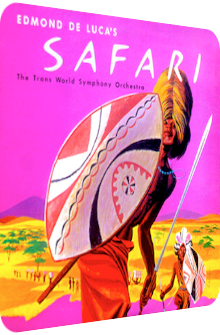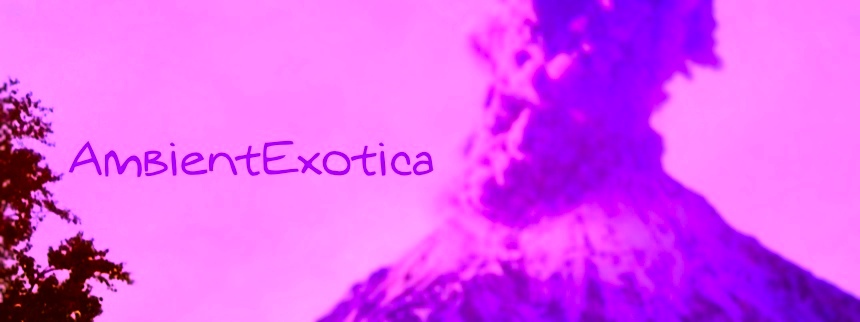
Edmond De Luca
Safari
1958
Composer and arranger Edmond De Luca (1909–2004) acted mostly behind the curtains of the music scene, having been a regular writer of unique symphonic compositions for David L. Miller's world-famous orchestra and brand called the 101 Strings. De Luca's only exotic entry in his discography, the wondrously shape-shifting Exotica travelog Safari, is thus unsurprisingly flacked by Miller and released on his own Somerset label in 1958, a few months after the debut of his 101 Strings orchestra, A Night In The Tropics from 1957. And even on Safari, De Luca's role is that of a composer only; the album is actually conducted by Heinrich Alster and large parts of his Hamburg Philharmonia Orchestra. This orchestra is then regrouped in order to form the greatly named The Trans World Symphony Orchestra, complete with an all-male choir.
Side A features the original incarnation of De Luca's Safari, a conceptual travelog of a group of visitors who get to know the exciting mysteries of Africa with the help of their guiding Natives. From beautiful boat tours across jungle rivers over impressive mountain outlooks to dangerous hunting sessions, the roughly 20 minutes of Safari are enormously vivid and pieced together by shorter vignettes and sections. Exotic percussion, clarion horns, Hollywood strings and mellow flutes meet, mesh and depart incessantly. Side B is conceptually detached, features another 20 minutes of playtime and only two compositions taken from the material of Russian composer Alexander Borodin and his Spanish foil Manuel De Falla. Safari turns out to be a high-budget production that even depicts short textual explanations. These then embed each song in the storyline.
It is a concept album in the veins of Arthur Lyman's The Legend Of Pele (1958), Dominic Frontiere's Pagan Festival (1959) and Stanley Wilson's Pagan Love (1961), but the question remains whether it is an honest-to-earth Exotica LP? I believe so. It may not present faux-Polynesian jungles, but meshes its Western production with the African Steppe as well as jungles full of savages and is thus more closely related to Tak Shindo's Exotica debut Mganga! (1958) than anything. The coalescence of romance and savage insinuations is hence the aesthetic leitmotif of Safari, and I for one am ready to take part in it the gazillionth time, this time documenting my impressions for everyone to see.
A coastal steamer from Mombasa prepares to land in Port Pangani on Africa's East Coast, with its passengers pleasantly anticipating the forthcoming safari. This outlook is given in the liner notes, and though the description is rather short, it strangely enough does not feel gimmicky or irrelevant, not even after all these years of the album's existence. The first vivaciously rising string washes provide the first glimpses of the setting, and today's listeners might have encountered them in the same prelude form on the Ambient Dub collective The Orb's quirky lullaby single The Land Of Green Ginger (2002/03). The orchestra then unleashes pompous two-note brass fanfares that encapsulate the wideness and true impact of the commencing journey. Their cascading downfall seems dusky, and the strings spiral downwards into unexpectedly gloomy territories before they reach a silky mellifluous state again, but these counteracting sequences in such a short amount of time underpin the fact that this is not the listener's typically picayune Easy Listening mediocrity he or she has encountered so often.
Once glinting marimba aortas and timpani-fueled kettle beat structures are unleashed in adjacency to pressing strings and hectic brass outbursts, Port Pangani meshes the Hollywood setting with a rather clichéd but impressively savage outing, the latter of which is further expanded by an earth-shaking drum solo. The final phase of the song implies a sunrise, with whirling harp glissandos and legato violins being joined by paradisiac flutes which altogether create one of the mightiest euphonies of the whole album. The opener then feels more like a finale. A great start, even though its shape-shifting form demands a bit more from the listener and does not work all too well in isolated form, for example in an Exotica playlist of mixed material. Port Pangani is a miniature suite camouflaged as one little song, akin to Dominic Frontiere's first composition Festival off Pagan Festival.
The following Bantu Village is the next destination of the group and reached via boat across the Ruvu River with lush palm trees and green thickets surrounding it. Rapid-firing drums are hence used right from the beginning, a male choir joins immediately, singing lyricless chants. Sizzling maracas, uplifting pizzicato strings and amicable trombones round off the composition's first phase which is followed by languorous alto flute solos, distant string washes and an overall forlorn carefreeness. Ruvu River is transfigured into a romantic theme of love that could occur in every major film production of the 50's in exactly this way. The exotic factor is then revved up again with the mighty crescendo of horns that lead to the reappearance of the first choir-accompanied theme.
The next stop, then, is Mt. Kilimanjaro. The soundscape is solely about this mountain's grandeur and impressive vista. Tick-tocking claves, another dose of male choir chants in higher regions, Roman-esque brass flourishes as well as exciting string concoctions all try to aurally capture the impressive image over the various stages. The second phase is especially noteworthy for its klaxon horns, bird-resembling flutes and balmy harp infusions. Everything seems gigantic in this arrangement, and once the exotic percussion wanes, Mt. Kilimanjaro feels once again like the soundtrack to a Hollywood picture that takes place in concrete jungles. If you are fond of a grandiloquent beatless wideness, this composition offers it big time.
The Trek sees the group and their Native guides moving towards the dry plains. Since there is steady movement involved in this part of the journey, the percussion scheme is more prominently featured and the song is comparably easygoing and laid-back in comparison to the ever-changing kaleidoscope of the other compositions. De Luca composes a distantly Far Eastern string melody and places it in-between Chinese gongs, aqueous bamboo rods plus congas, and trombone-underlined flute melodies whose soothing effects are then widened by lachrymose string sections, some of them decidedly warped and rooted in Space-Age realms. The Trek is a proper tune in that its state is maintained throughout its runtime, no short pauses or rhythm shifts perturb the march of the group.
It is therefore the most accessible piece that works perfectly on its own when detached from its context; although one would then miss the thematically connected The Chase And Kill, for the hunters have now spotted a brutish beast they want to slay. Unsurprisingly, the mood is enormously intense, with towering brass injections and constant timpani quakes making up the majority of the track. Especially the trumpets, saxophones and trombones gleam and shine, evoke hope, danger, honor and excitement. Their esprit is magnificent! While the rhythm remains the same, the instruments swell in voluminosity, with the final whiplash slaps and the ensuing brass dissonance marking the glorious end of the hunt. The final song of side A is also the apotheosis to the adventurous Safari. Called The Trek Back, this short closing vignette is mild-mannered and shows the fatigue and pride of the hunters who have proven their skills to great success. Such being the case, the strings are sweeping romantically, the percussion is mostly silent aside from the gentle bongo droplets at the end, and the harp scintillae which ennoble the solemnity of the aftermath.
Wait, there is indeed more, for side B may not be attached to the concept of the titular safari, but comprises two shiny contributions from the feathers of Alexander Borodin and Manuel De Falla that are not overly exotic on their own, but are realized with the same orchestra, so from a textural and timbre-related viewpoint, they fit into the theme. Both compositions are conducted by Heinrich Alster. Borodin's Polovtsian Dances is taken off his 1890 opera Prince Igor and is most impressive with its duration of almost 14 minutes! It launches with mellow flute melodies, underlining clarinets and bubbling harps. The aura is pristine and benign, but not overly exotic yet. In its third minute however, the composition opens up and features smashing horns, exotic bamboo rods, maracas and other snake-resembling rattling shakers. Whatever the phase of the composition currently is, the orchestral impetus is always huge, but undoubtedly more rooted in the Occidental ways of composing. The many artificial injections of exotic particles unfortunately remain lifeless since the focus targets the strings and the flutes whose melodies shuttle between downbeat romance and coruscating frenzy, but alas, the tone sequences do not induce an exotic feeling, although shortly before the ten-minute-mark, conductor Alster sneaks a few (accidental?) traces of Ernesto Lecuona's Andalucía aka The Breeze And I into the mix.
Ending the composition with a whooshing staccato gallimaufry, Polovtsian Dances is labyrinthine yet accessible, but definitely not related to Exotica settings at all. Manuel De Falla's following Ritual Fire Dance is better known in Exotica circles and all the more dependent on the conductor or the arranger; Morton Gould's take on his 1957 opus Jungle Drums comes to mind, but while its mildly lamenting and playful lead melody is fully intact, the ensuing mélange of horns, diffuse timpani and bumblebee-like strings is rhizomatically tied to classical realms. Exotica is farther away than ever, so side A has to do it for me.
Rarely do I encounter Exotica records where side B is as unnecessary as on Edmond De Luca's Safari. This fact is all the more schizophrenic, for the two compositions by Alexander Borodin and Manuel De Falla are truly impressive in their conducted forms as delivered by Heinrich Alster, but not the least bit exotic. So I see side B as a bonus, move on and rather bathe in the enchanting excitement of Edmond De Luca's Exotica suite called Safari. The constant shifts and changed appearances of the unique arrangements are breathtaking, if also demanding and potentially tiresome, but since the suite is only about 20 minutes long thanks to the physical limits of vinyl, it provides a stringent stream of vivid stops during an exciting journey. The idea of tying music to short textual explanations is not new, but in the realms of Exotica, it is surprisingly rare and should thus be noted, if not necessarily worshipped.
From the Space-Age strings over the flamboyant horn blasts to the silky flute accents, Safari is a great album and one of those equally rare symphonic works that do not unchain endless amounts of timpani rather than marrying them with congas, bamboo rods, maracas and claves. All six compositions of side A are unique and specifically written with Safari in mind, so you will not find them in different versions anywhere else. The melodies are not overly strong, you probably cannot hum along to most phases, but what this release lacks in eternal melodies, it offers in the form of wonderful textures, a large orchestra and an entangled interplay. While Safari ranks in third place compared to Dominic Frontiere's Pagan Festival and Stanley Wilson's Pagan Love, both in terms of its exotic factor and the melodies, it is nonetheless a superb concept album with an enormous wealth of textures and sections.
Although it sometimes feels like a patchwork of short segues and intersections, it remains a gem. If you are searching for the digital release, remember to search for the name of the orchestra rather than De Luca's, since a name such as The Trans World Symphony Orchestra sounds indeed more promotional and cooler in today's times. Unfortunately, the digital version sounds a bit bland. Either the master tapes have suffered over the decades or were not used at all. The vinyl is nonetheless quite cheap and available at the usual places, for instance Bay and Amazon.
Exotica Review 190: Edmond De Luca – Safari (1958). Originally published on Mar. 9, 2013 at AmbientExotica.com.
